Analyzing the Supply Chain Management of Nescafe in Bangladesh
VerifiedAdded on 2022/11/17
|20
|5696
|3
Report
AI Summary
This term paper analyzes the supply chain management of Nescafe, a product of Nestle Bangladesh Ltd. The study focuses on the sourcing of raw materials, the distribution strategy, and the overall effectiveness of the supply chain, specifically within the Bangladeshi market. The research methodology includes primary data collected from interviews with Nestle Bangladesh officials and secondary data from websites. The paper explores the supply chain management concept, including the roles of suppliers, manufacturers, distributors, retailers, and consumers. It also examines the integral flows of supply chain management: product flow, information flow, and financial flow, along with the five components of supply chain management (plan, procurement, make, deliver, and return). The report aims to provide insights into the supply chain operations of Nescafe in Bangladesh, identifying potential areas for improvement and modification.
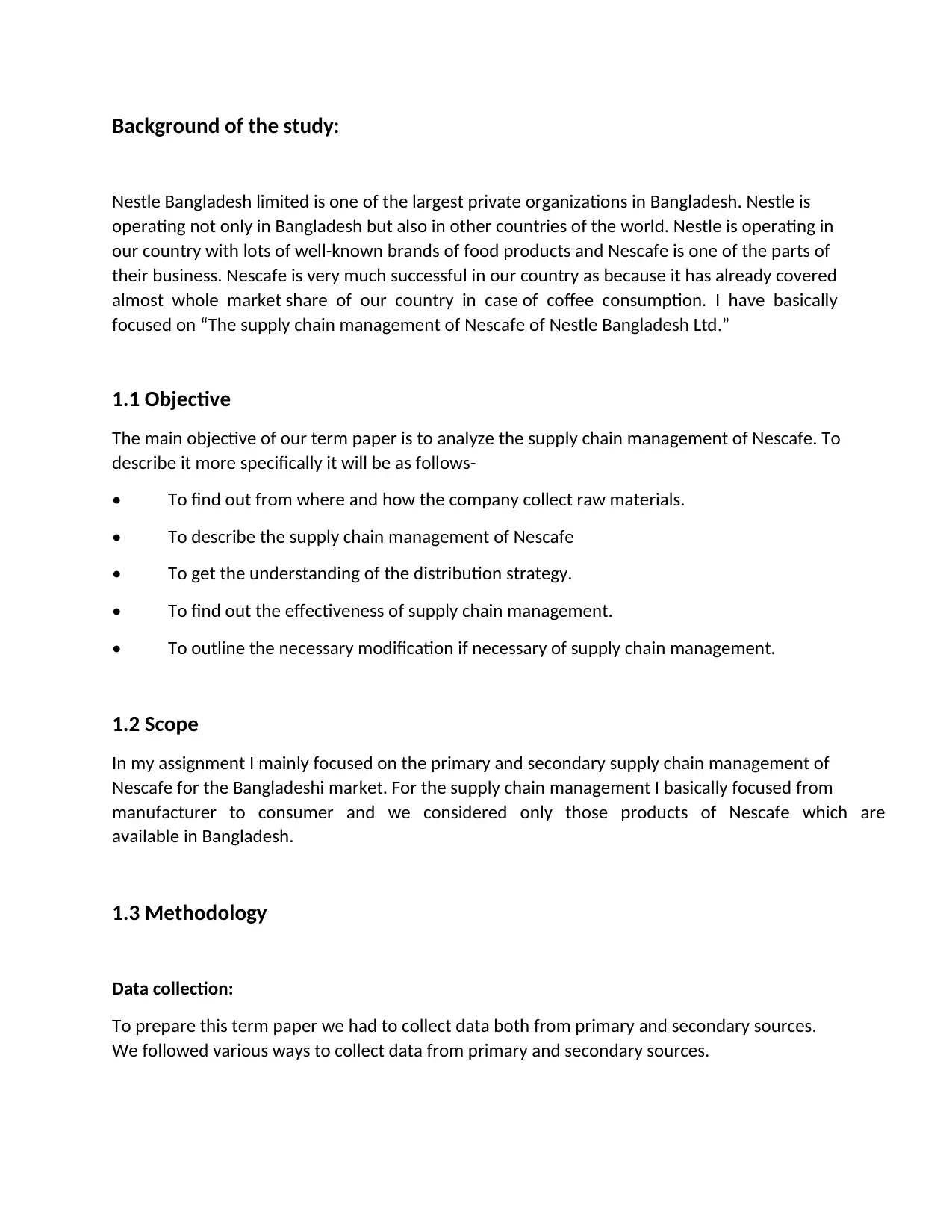
Background of the study:
Nestle Bangladesh limited is one of the largest private organizations in Bangladesh. Nestle is
operating not only in Bangladesh but also in other countries of the world. Nestle is operating in
our country with lots of well-known brands of food products and Nescafe is one of the parts of
their business. Nescafe is very much successful in our country as because it has already covered
almost whole market share of our country in case of coffee consumption. I have basically
focused on “The supply chain management of Nescafe of Nestle Bangladesh Ltd.”
1.1 Objective
The main objective of our term paper is to analyze the supply chain management of Nescafe. To
describe it more specifically it will be as follows-
• To find out from where and how the company collect raw materials.
• To describe the supply chain management of Nescafe
• To get the understanding of the distribution strategy.
• To find out the effectiveness of supply chain management.
• To outline the necessary modification if necessary of supply chain management.
1.2 Scope
In my assignment I mainly focused on the primary and secondary supply chain management of
Nescafe for the Bangladeshi market. For the supply chain management I basically focused from
manufacturer to consumer and we considered only those products of Nescafe which are
available in Bangladesh.
1.3 Methodology
Data collection:
To prepare this term paper we had to collect data both from primary and secondary sources.
We followed various ways to collect data from primary and secondary sources.
Nestle Bangladesh limited is one of the largest private organizations in Bangladesh. Nestle is
operating not only in Bangladesh but also in other countries of the world. Nestle is operating in
our country with lots of well-known brands of food products and Nescafe is one of the parts of
their business. Nescafe is very much successful in our country as because it has already covered
almost whole market share of our country in case of coffee consumption. I have basically
focused on “The supply chain management of Nescafe of Nestle Bangladesh Ltd.”
1.1 Objective
The main objective of our term paper is to analyze the supply chain management of Nescafe. To
describe it more specifically it will be as follows-
• To find out from where and how the company collect raw materials.
• To describe the supply chain management of Nescafe
• To get the understanding of the distribution strategy.
• To find out the effectiveness of supply chain management.
• To outline the necessary modification if necessary of supply chain management.
1.2 Scope
In my assignment I mainly focused on the primary and secondary supply chain management of
Nescafe for the Bangladeshi market. For the supply chain management I basically focused from
manufacturer to consumer and we considered only those products of Nescafe which are
available in Bangladesh.
1.3 Methodology
Data collection:
To prepare this term paper we had to collect data both from primary and secondary sources.
We followed various ways to collect data from primary and secondary sources.
Paraphrase This Document
Need a fresh take? Get an instant paraphrase of this document with our AI Paraphraser
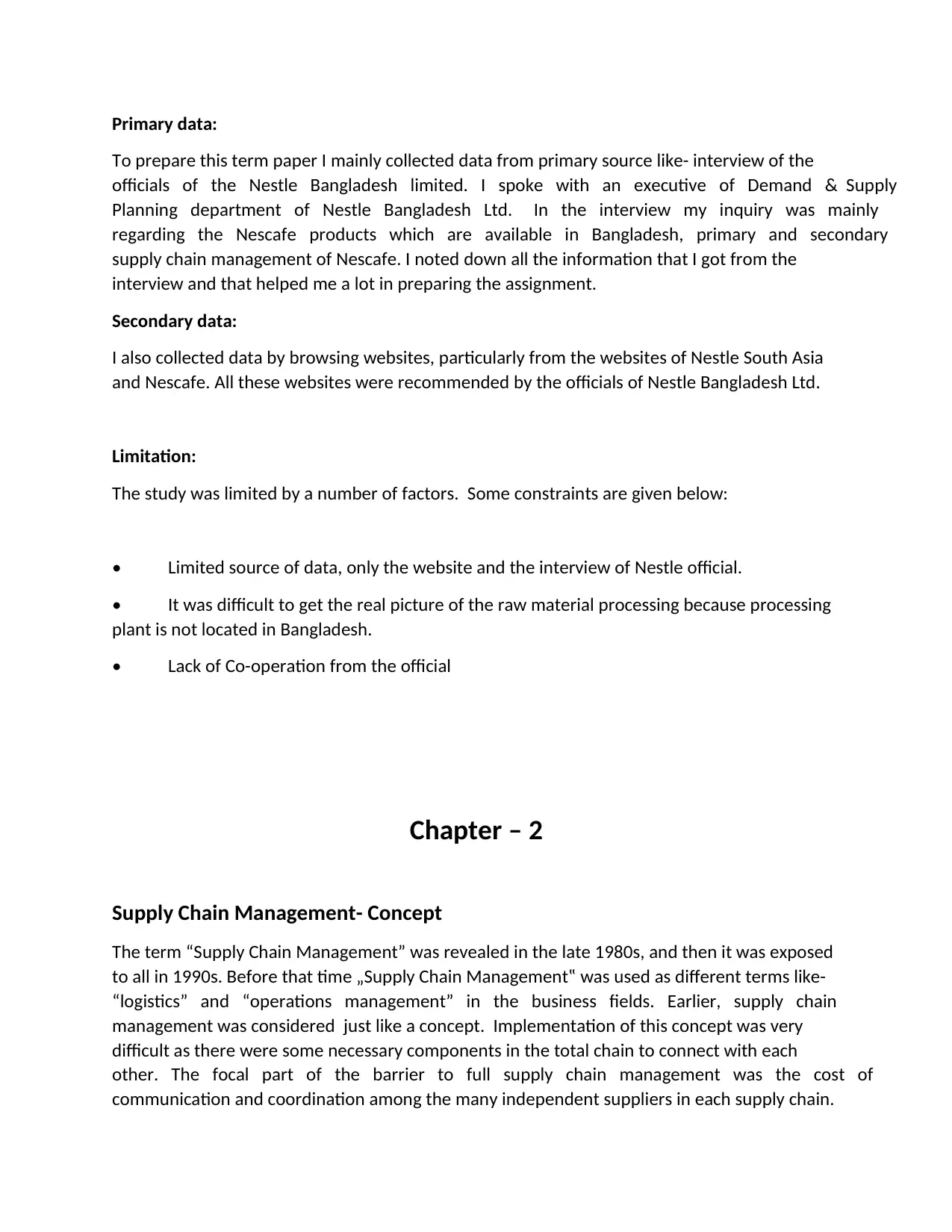
Primary data:
To prepare this term paper I mainly collected data from primary source like- interview of the
officials of the Nestle Bangladesh limited. I spoke with an executive of Demand & Supply
Planning department of Nestle Bangladesh Ltd. In the interview my inquiry was mainly
regarding the Nescafe products which are available in Bangladesh, primary and secondary
supply chain management of Nescafe. I noted down all the information that I got from the
interview and that helped me a lot in preparing the assignment.
Secondary data:
I also collected data by browsing websites, particularly from the websites of Nestle South Asia
and Nescafe. All these websites were recommended by the officials of Nestle Bangladesh Ltd.
Limitation:
The study was limited by a number of factors. Some constraints are given below:
• Limited source of data, only the website and the interview of Nestle official.
• It was difficult to get the real picture of the raw material processing because processing
plant is not located in Bangladesh.
• Lack of Co-operation from the official
Chapter – 2
Supply Chain Management- Concept
The term “Supply Chain Management” was revealed in the late 1980s, and then it was exposed
to all in 1990s. Before that time „Supply Chain Management‟ was used as different terms like-
“logistics” and “operations management” in the business fields. Earlier, supply chain
management was considered just like a concept. Implementation of this concept was very
difficult as there were some necessary components in the total chain to connect with each
other. The focal part of the barrier to full supply chain management was the cost of
communication and coordination among the many independent suppliers in each supply chain.
To prepare this term paper I mainly collected data from primary source like- interview of the
officials of the Nestle Bangladesh limited. I spoke with an executive of Demand & Supply
Planning department of Nestle Bangladesh Ltd. In the interview my inquiry was mainly
regarding the Nescafe products which are available in Bangladesh, primary and secondary
supply chain management of Nescafe. I noted down all the information that I got from the
interview and that helped me a lot in preparing the assignment.
Secondary data:
I also collected data by browsing websites, particularly from the websites of Nestle South Asia
and Nescafe. All these websites were recommended by the officials of Nestle Bangladesh Ltd.
Limitation:
The study was limited by a number of factors. Some constraints are given below:
• Limited source of data, only the website and the interview of Nestle official.
• It was difficult to get the real picture of the raw material processing because processing
plant is not located in Bangladesh.
• Lack of Co-operation from the official
Chapter – 2
Supply Chain Management- Concept
The term “Supply Chain Management” was revealed in the late 1980s, and then it was exposed
to all in 1990s. Before that time „Supply Chain Management‟ was used as different terms like-
“logistics” and “operations management” in the business fields. Earlier, supply chain
management was considered just like a concept. Implementation of this concept was very
difficult as there were some necessary components in the total chain to connect with each
other. The focal part of the barrier to full supply chain management was the cost of
communication and coordination among the many independent suppliers in each supply chain.
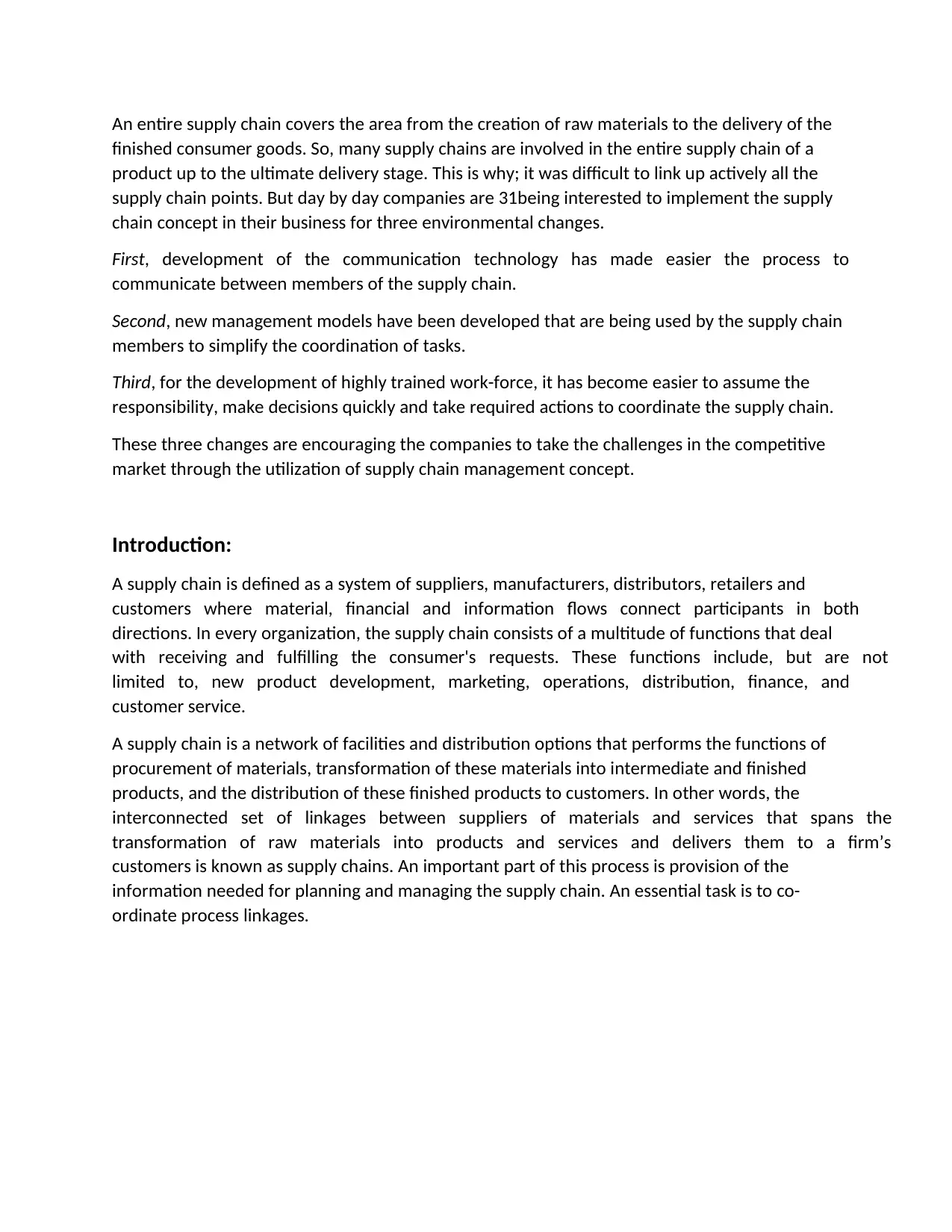
An entire supply chain covers the area from the creation of raw materials to the delivery of the
finished consumer goods. So, many supply chains are involved in the entire supply chain of a
product up to the ultimate delivery stage. This is why; it was difficult to link up actively all the
supply chain points. But day by day companies are 31being interested to implement the supply
chain concept in their business for three environmental changes.
First, development of the communication technology has made easier the process to
communicate between members of the supply chain.
Second, new management models have been developed that are being used by the supply chain
members to simplify the coordination of tasks.
Third, for the development of highly trained work-force, it has become easier to assume the
responsibility, make decisions quickly and take required actions to coordinate the supply chain.
These three changes are encouraging the companies to take the challenges in the competitive
market through the utilization of supply chain management concept.
Introduction:
A supply chain is defined as a system of suppliers, manufacturers, distributors, retailers and
customers where material, financial and information flows connect participants in both
directions. In every organization, the supply chain consists of a multitude of functions that deal
with receiving and fulfilling the consumer's requests. These functions include, but are not
limited to, new product development, marketing, operations, distribution, finance, and
customer service.
A supply chain is a network of facilities and distribution options that performs the functions of
procurement of materials, transformation of these materials into intermediate and finished
products, and the distribution of these finished products to customers. In other words, the
interconnected set of linkages between suppliers of materials and services that spans the
transformation of raw materials into products and services and delivers them to a firm’s
customers is known as supply chains. An important part of this process is provision of the
information needed for planning and managing the supply chain. An essential task is to co-
ordinate process linkages.
finished consumer goods. So, many supply chains are involved in the entire supply chain of a
product up to the ultimate delivery stage. This is why; it was difficult to link up actively all the
supply chain points. But day by day companies are 31being interested to implement the supply
chain concept in their business for three environmental changes.
First, development of the communication technology has made easier the process to
communicate between members of the supply chain.
Second, new management models have been developed that are being used by the supply chain
members to simplify the coordination of tasks.
Third, for the development of highly trained work-force, it has become easier to assume the
responsibility, make decisions quickly and take required actions to coordinate the supply chain.
These three changes are encouraging the companies to take the challenges in the competitive
market through the utilization of supply chain management concept.
Introduction:
A supply chain is defined as a system of suppliers, manufacturers, distributors, retailers and
customers where material, financial and information flows connect participants in both
directions. In every organization, the supply chain consists of a multitude of functions that deal
with receiving and fulfilling the consumer's requests. These functions include, but are not
limited to, new product development, marketing, operations, distribution, finance, and
customer service.
A supply chain is a network of facilities and distribution options that performs the functions of
procurement of materials, transformation of these materials into intermediate and finished
products, and the distribution of these finished products to customers. In other words, the
interconnected set of linkages between suppliers of materials and services that spans the
transformation of raw materials into products and services and delivers them to a firm’s
customers is known as supply chains. An important part of this process is provision of the
information needed for planning and managing the supply chain. An essential task is to co-
ordinate process linkages.
⊘ This is a preview!⊘
Do you want full access?
Subscribe today to unlock all pages.

Trusted by 1+ million students worldwide
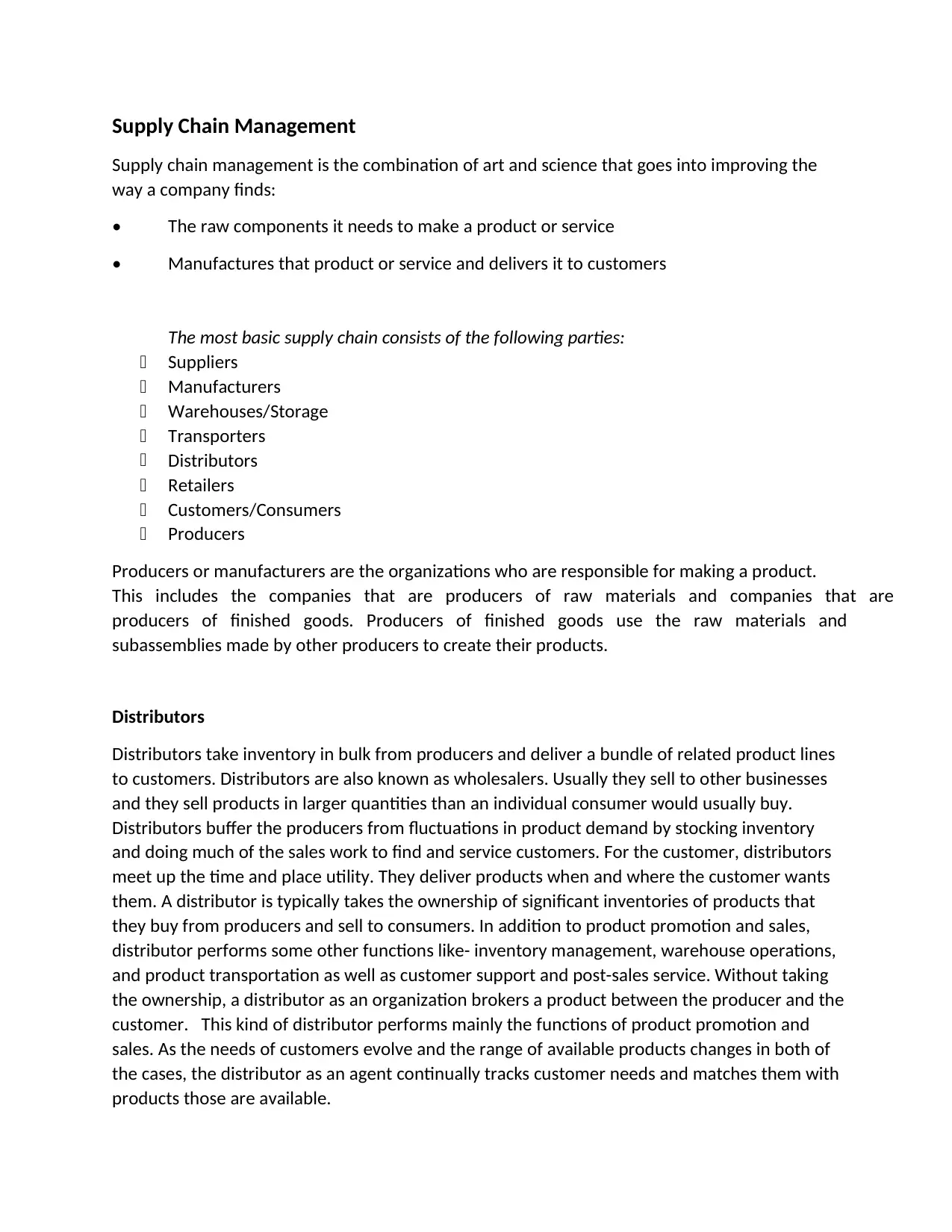
Supply Chain Management
Supply chain management is the combination of art and science that goes into improving the
way a company finds:
• The raw components it needs to make a product or service
• Manufactures that product or service and delivers it to customers
The most basic supply chain consists of the following parties:
Suppliers
Manufacturers
Warehouses/Storage
Transporters
Distributors
Retailers
Customers/Consumers
Producers
Producers or manufacturers are the organizations who are responsible for making a product.
This includes the companies that are producers of raw materials and companies that are
producers of finished goods. Producers of finished goods use the raw materials and
subassemblies made by other producers to create their products.
Distributors
Distributors take inventory in bulk from producers and deliver a bundle of related product lines
to customers. Distributors are also known as wholesalers. Usually they sell to other businesses
and they sell products in larger quantities than an individual consumer would usually buy.
Distributors buffer the producers from fluctuations in product demand by stocking inventory
and doing much of the sales work to find and service customers. For the customer, distributors
meet up the time and place utility. They deliver products when and where the customer wants
them. A distributor is typically takes the ownership of significant inventories of products that
they buy from producers and sell to consumers. In addition to product promotion and sales,
distributor performs some other functions like- inventory management, warehouse operations,
and product transportation as well as customer support and post-sales service. Without taking
the ownership, a distributor as an organization brokers a product between the producer and the
customer. This kind of distributor performs mainly the functions of product promotion and
sales. As the needs of customers evolve and the range of available products changes in both of
the cases, the distributor as an agent continually tracks customer needs and matches them with
products those are available.
Supply chain management is the combination of art and science that goes into improving the
way a company finds:
• The raw components it needs to make a product or service
• Manufactures that product or service and delivers it to customers
The most basic supply chain consists of the following parties:
Suppliers
Manufacturers
Warehouses/Storage
Transporters
Distributors
Retailers
Customers/Consumers
Producers
Producers or manufacturers are the organizations who are responsible for making a product.
This includes the companies that are producers of raw materials and companies that are
producers of finished goods. Producers of finished goods use the raw materials and
subassemblies made by other producers to create their products.
Distributors
Distributors take inventory in bulk from producers and deliver a bundle of related product lines
to customers. Distributors are also known as wholesalers. Usually they sell to other businesses
and they sell products in larger quantities than an individual consumer would usually buy.
Distributors buffer the producers from fluctuations in product demand by stocking inventory
and doing much of the sales work to find and service customers. For the customer, distributors
meet up the time and place utility. They deliver products when and where the customer wants
them. A distributor is typically takes the ownership of significant inventories of products that
they buy from producers and sell to consumers. In addition to product promotion and sales,
distributor performs some other functions like- inventory management, warehouse operations,
and product transportation as well as customer support and post-sales service. Without taking
the ownership, a distributor as an organization brokers a product between the producer and the
customer. This kind of distributor performs mainly the functions of product promotion and
sales. As the needs of customers evolve and the range of available products changes in both of
the cases, the distributor as an agent continually tracks customer needs and matches them with
products those are available.
Paraphrase This Document
Need a fresh take? Get an instant paraphrase of this document with our AI Paraphraser
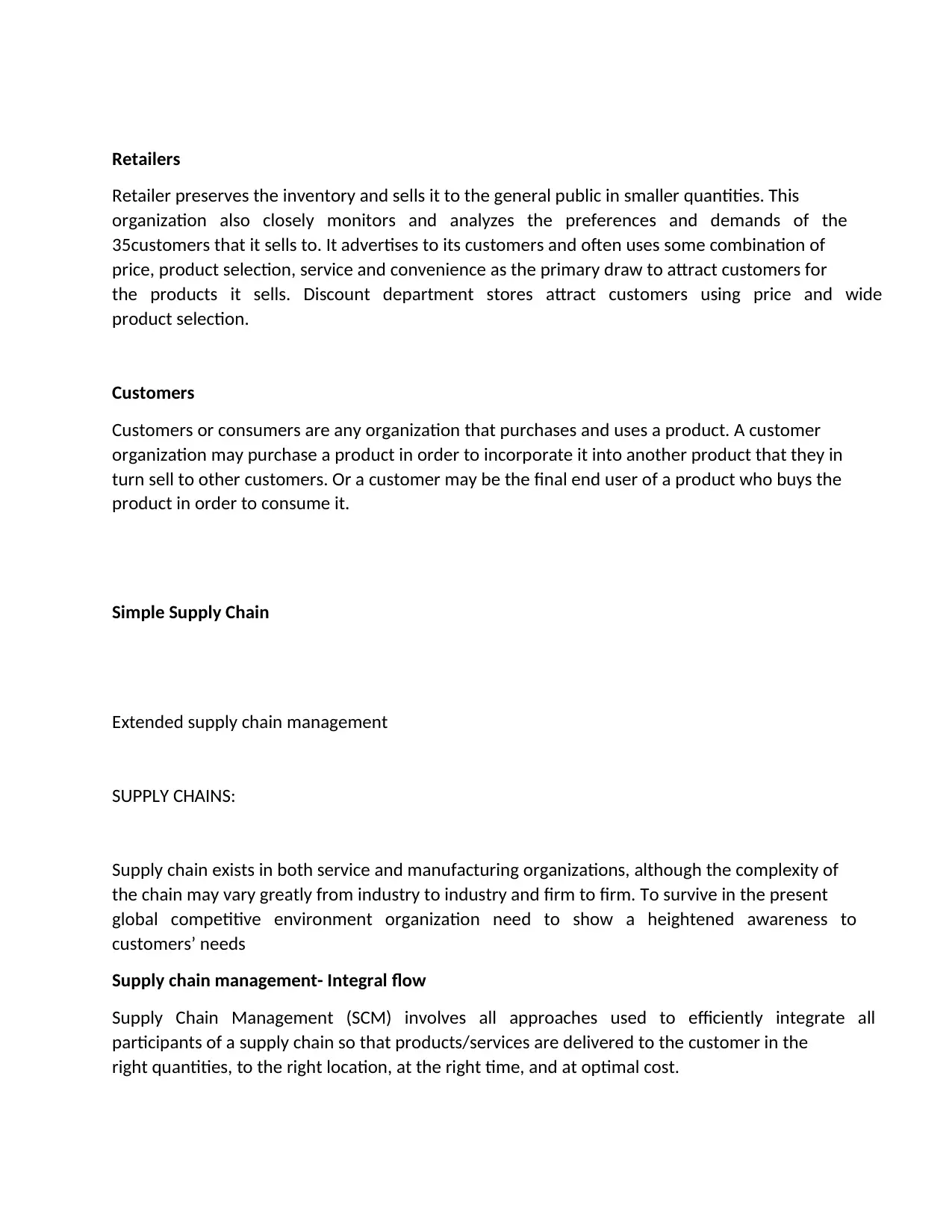
Retailers
Retailer preserves the inventory and sells it to the general public in smaller quantities. This
organization also closely monitors and analyzes the preferences and demands of the
35customers that it sells to. It advertises to its customers and often uses some combination of
price, product selection, service and convenience as the primary draw to attract customers for
the products it sells. Discount department stores attract customers using price and wide
product selection.
Customers
Customers or consumers are any organization that purchases and uses a product. A customer
organization may purchase a product in order to incorporate it into another product that they in
turn sell to other customers. Or a customer may be the final end user of a product who buys the
product in order to consume it.
Simple Supply Chain
Extended supply chain management
SUPPLY CHAINS:
Supply chain exists in both service and manufacturing organizations, although the complexity of
the chain may vary greatly from industry to industry and firm to firm. To survive in the present
global competitive environment organization need to show a heightened awareness to
customers’ needs
Supply chain management- Integral flow
Supply Chain Management (SCM) involves all approaches used to efficiently integrate all
participants of a supply chain so that products/services are delivered to the customer in the
right quantities, to the right location, at the right time, and at optimal cost.
Retailer preserves the inventory and sells it to the general public in smaller quantities. This
organization also closely monitors and analyzes the preferences and demands of the
35customers that it sells to. It advertises to its customers and often uses some combination of
price, product selection, service and convenience as the primary draw to attract customers for
the products it sells. Discount department stores attract customers using price and wide
product selection.
Customers
Customers or consumers are any organization that purchases and uses a product. A customer
organization may purchase a product in order to incorporate it into another product that they in
turn sell to other customers. Or a customer may be the final end user of a product who buys the
product in order to consume it.
Simple Supply Chain
Extended supply chain management
SUPPLY CHAINS:
Supply chain exists in both service and manufacturing organizations, although the complexity of
the chain may vary greatly from industry to industry and firm to firm. To survive in the present
global competitive environment organization need to show a heightened awareness to
customers’ needs
Supply chain management- Integral flow
Supply Chain Management (SCM) involves all approaches used to efficiently integrate all
participants of a supply chain so that products/services are delivered to the customer in the
right quantities, to the right location, at the right time, and at optimal cost.
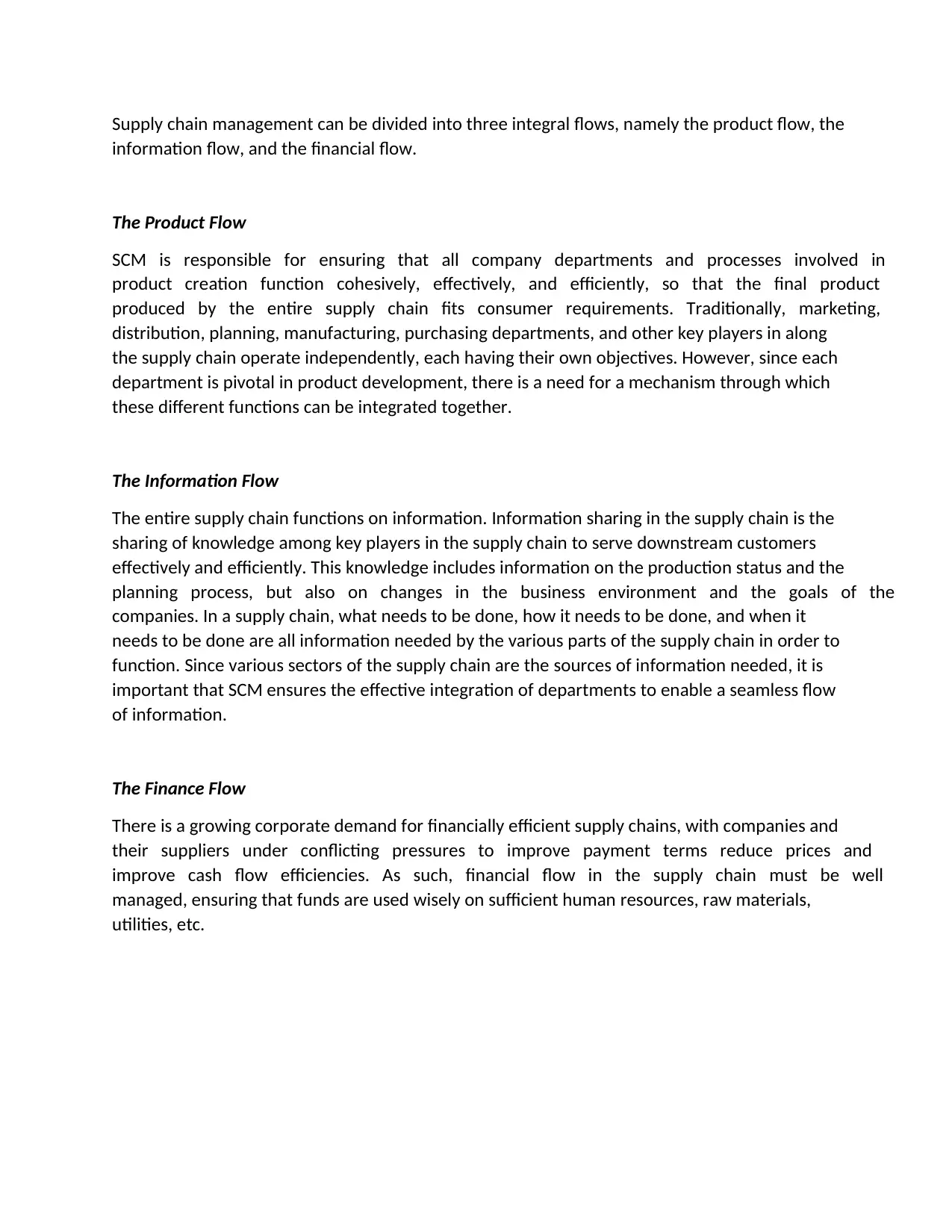
Supply chain management can be divided into three integral flows, namely the product flow, the
information flow, and the financial flow.
The Product Flow
SCM is responsible for ensuring that all company departments and processes involved in
product creation function cohesively, effectively, and efficiently, so that the final product
produced by the entire supply chain fits consumer requirements. Traditionally, marketing,
distribution, planning, manufacturing, purchasing departments, and other key players in along
the supply chain operate independently, each having their own objectives. However, since each
department is pivotal in product development, there is a need for a mechanism through which
these different functions can be integrated together.
The Information Flow
The entire supply chain functions on information. Information sharing in the supply chain is the
sharing of knowledge among key players in the supply chain to serve downstream customers
effectively and efficiently. This knowledge includes information on the production status and the
planning process, but also on changes in the business environment and the goals of the
companies. In a supply chain, what needs to be done, how it needs to be done, and when it
needs to be done are all information needed by the various parts of the supply chain in order to
function. Since various sectors of the supply chain are the sources of information needed, it is
important that SCM ensures the effective integration of departments to enable a seamless flow
of information.
The Finance Flow
There is a growing corporate demand for financially efficient supply chains, with companies and
their suppliers under conflicting pressures to improve payment terms reduce prices and
improve cash flow efficiencies. As such, financial flow in the supply chain must be well
managed, ensuring that funds are used wisely on sufficient human resources, raw materials,
utilities, etc.
information flow, and the financial flow.
The Product Flow
SCM is responsible for ensuring that all company departments and processes involved in
product creation function cohesively, effectively, and efficiently, so that the final product
produced by the entire supply chain fits consumer requirements. Traditionally, marketing,
distribution, planning, manufacturing, purchasing departments, and other key players in along
the supply chain operate independently, each having their own objectives. However, since each
department is pivotal in product development, there is a need for a mechanism through which
these different functions can be integrated together.
The Information Flow
The entire supply chain functions on information. Information sharing in the supply chain is the
sharing of knowledge among key players in the supply chain to serve downstream customers
effectively and efficiently. This knowledge includes information on the production status and the
planning process, but also on changes in the business environment and the goals of the
companies. In a supply chain, what needs to be done, how it needs to be done, and when it
needs to be done are all information needed by the various parts of the supply chain in order to
function. Since various sectors of the supply chain are the sources of information needed, it is
important that SCM ensures the effective integration of departments to enable a seamless flow
of information.
The Finance Flow
There is a growing corporate demand for financially efficient supply chains, with companies and
their suppliers under conflicting pressures to improve payment terms reduce prices and
improve cash flow efficiencies. As such, financial flow in the supply chain must be well
managed, ensuring that funds are used wisely on sufficient human resources, raw materials,
utilities, etc.
⊘ This is a preview!⊘
Do you want full access?
Subscribe today to unlock all pages.

Trusted by 1+ million students worldwide
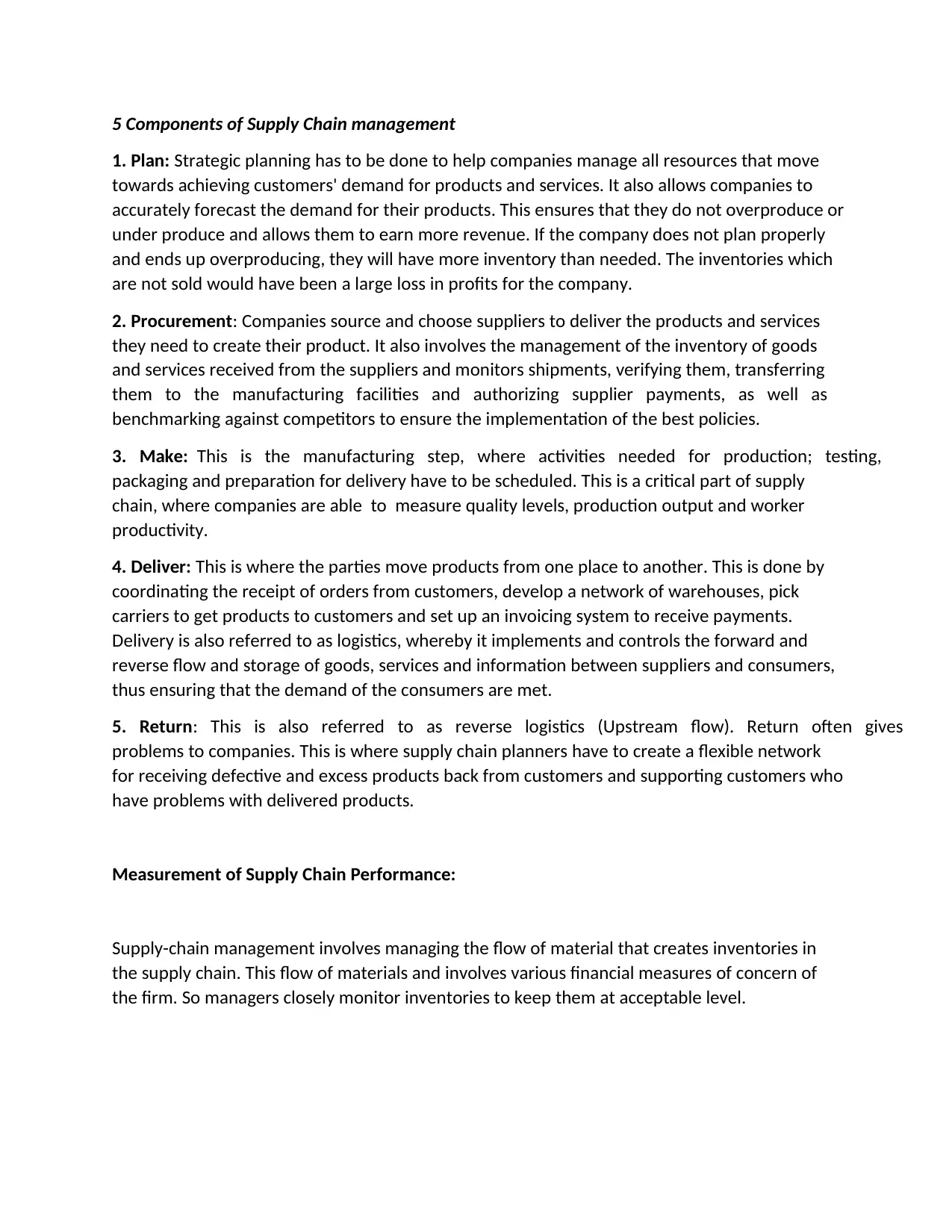
5 Components of Supply Chain management
1. Plan: Strategic planning has to be done to help companies manage all resources that move
towards achieving customers' demand for products and services. It also allows companies to
accurately forecast the demand for their products. This ensures that they do not overproduce or
under produce and allows them to earn more revenue. If the company does not plan properly
and ends up overproducing, they will have more inventory than needed. The inventories which
are not sold would have been a large loss in profits for the company.
2. Procurement: Companies source and choose suppliers to deliver the products and services
they need to create their product. It also involves the management of the inventory of goods
and services received from the suppliers and monitors shipments, verifying them, transferring
them to the manufacturing facilities and authorizing supplier payments, as well as
benchmarking against competitors to ensure the implementation of the best policies.
3. Make: This is the manufacturing step, where activities needed for production; testing,
packaging and preparation for delivery have to be scheduled. This is a critical part of supply
chain, where companies are able to measure quality levels, production output and worker
productivity.
4. Deliver: This is where the parties move products from one place to another. This is done by
coordinating the receipt of orders from customers, develop a network of warehouses, pick
carriers to get products to customers and set up an invoicing system to receive payments.
Delivery is also referred to as logistics, whereby it implements and controls the forward and
reverse flow and storage of goods, services and information between suppliers and consumers,
thus ensuring that the demand of the consumers are met.
5. Return: This is also referred to as reverse logistics (Upstream flow). Return often gives
problems to companies. This is where supply chain planners have to create a flexible network
for receiving defective and excess products back from customers and supporting customers who
have problems with delivered products.
Measurement of Supply Chain Performance:
Supply-chain management involves managing the flow of material that creates inventories in
the supply chain. This flow of materials and involves various financial measures of concern of
the firm. So managers closely monitor inventories to keep them at acceptable level.
1. Plan: Strategic planning has to be done to help companies manage all resources that move
towards achieving customers' demand for products and services. It also allows companies to
accurately forecast the demand for their products. This ensures that they do not overproduce or
under produce and allows them to earn more revenue. If the company does not plan properly
and ends up overproducing, they will have more inventory than needed. The inventories which
are not sold would have been a large loss in profits for the company.
2. Procurement: Companies source and choose suppliers to deliver the products and services
they need to create their product. It also involves the management of the inventory of goods
and services received from the suppliers and monitors shipments, verifying them, transferring
them to the manufacturing facilities and authorizing supplier payments, as well as
benchmarking against competitors to ensure the implementation of the best policies.
3. Make: This is the manufacturing step, where activities needed for production; testing,
packaging and preparation for delivery have to be scheduled. This is a critical part of supply
chain, where companies are able to measure quality levels, production output and worker
productivity.
4. Deliver: This is where the parties move products from one place to another. This is done by
coordinating the receipt of orders from customers, develop a network of warehouses, pick
carriers to get products to customers and set up an invoicing system to receive payments.
Delivery is also referred to as logistics, whereby it implements and controls the forward and
reverse flow and storage of goods, services and information between suppliers and consumers,
thus ensuring that the demand of the consumers are met.
5. Return: This is also referred to as reverse logistics (Upstream flow). Return often gives
problems to companies. This is where supply chain planners have to create a flexible network
for receiving defective and excess products back from customers and supporting customers who
have problems with delivered products.
Measurement of Supply Chain Performance:
Supply-chain management involves managing the flow of material that creates inventories in
the supply chain. This flow of materials and involves various financial measures of concern of
the firm. So managers closely monitor inventories to keep them at acceptable level.
Paraphrase This Document
Need a fresh take? Get an instant paraphrase of this document with our AI Paraphraser
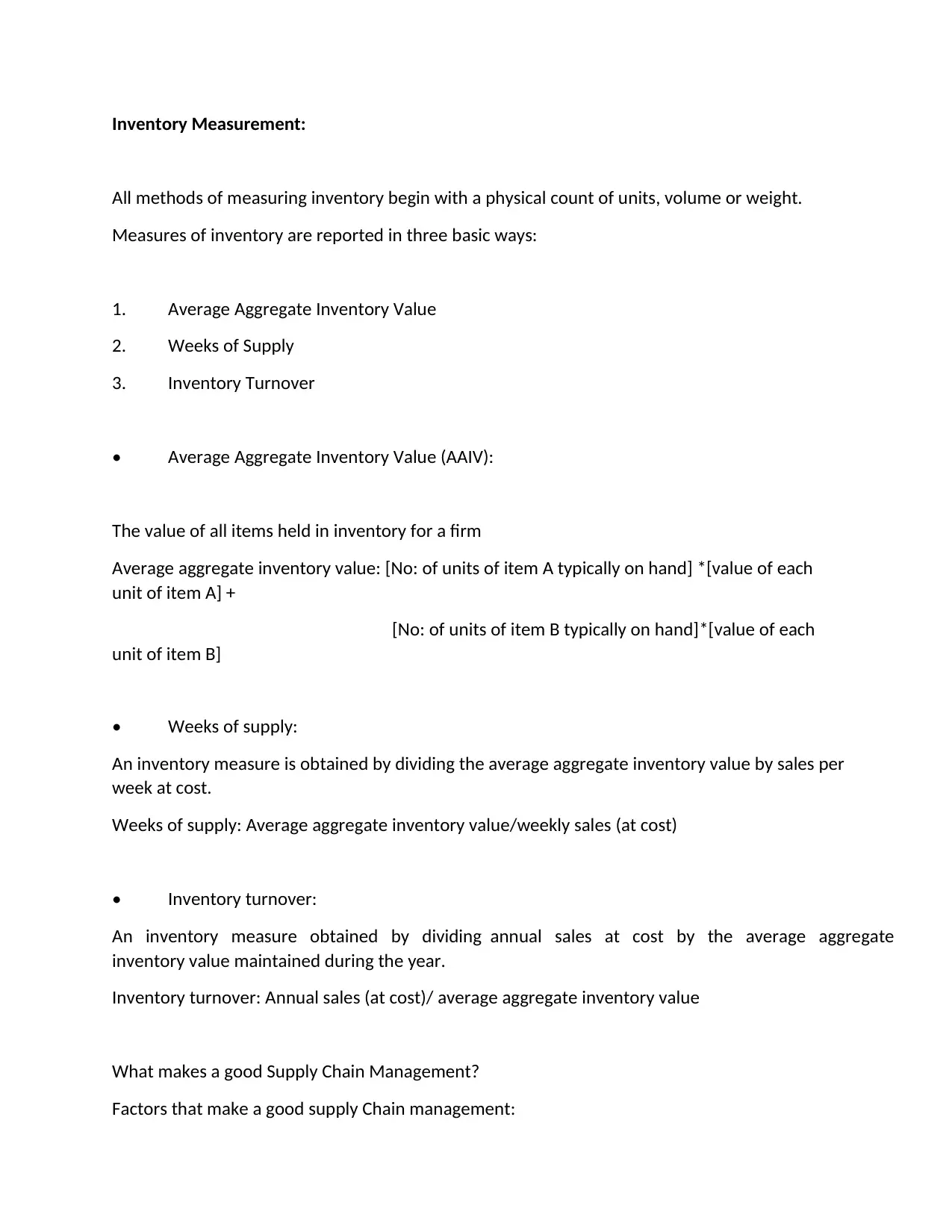
Inventory Measurement:
All methods of measuring inventory begin with a physical count of units, volume or weight.
Measures of inventory are reported in three basic ways:
1. Average Aggregate Inventory Value
2. Weeks of Supply
3. Inventory Turnover
• Average Aggregate Inventory Value (AAIV):
The value of all items held in inventory for a firm
Average aggregate inventory value: [No: of units of item A typically on hand] *[value of each
unit of item A] +
[No: of units of item B typically on hand]*[value of each
unit of item B]
• Weeks of supply:
An inventory measure is obtained by dividing the average aggregate inventory value by sales per
week at cost.
Weeks of supply: Average aggregate inventory value/weekly sales (at cost)
• Inventory turnover:
An inventory measure obtained by dividing annual sales at cost by the average aggregate
inventory value maintained during the year.
Inventory turnover: Annual sales (at cost)/ average aggregate inventory value
What makes a good Supply Chain Management?
Factors that make a good supply Chain management:
All methods of measuring inventory begin with a physical count of units, volume or weight.
Measures of inventory are reported in three basic ways:
1. Average Aggregate Inventory Value
2. Weeks of Supply
3. Inventory Turnover
• Average Aggregate Inventory Value (AAIV):
The value of all items held in inventory for a firm
Average aggregate inventory value: [No: of units of item A typically on hand] *[value of each
unit of item A] +
[No: of units of item B typically on hand]*[value of each
unit of item B]
• Weeks of supply:
An inventory measure is obtained by dividing the average aggregate inventory value by sales per
week at cost.
Weeks of supply: Average aggregate inventory value/weekly sales (at cost)
• Inventory turnover:
An inventory measure obtained by dividing annual sales at cost by the average aggregate
inventory value maintained during the year.
Inventory turnover: Annual sales (at cost)/ average aggregate inventory value
What makes a good Supply Chain Management?
Factors that make a good supply Chain management:
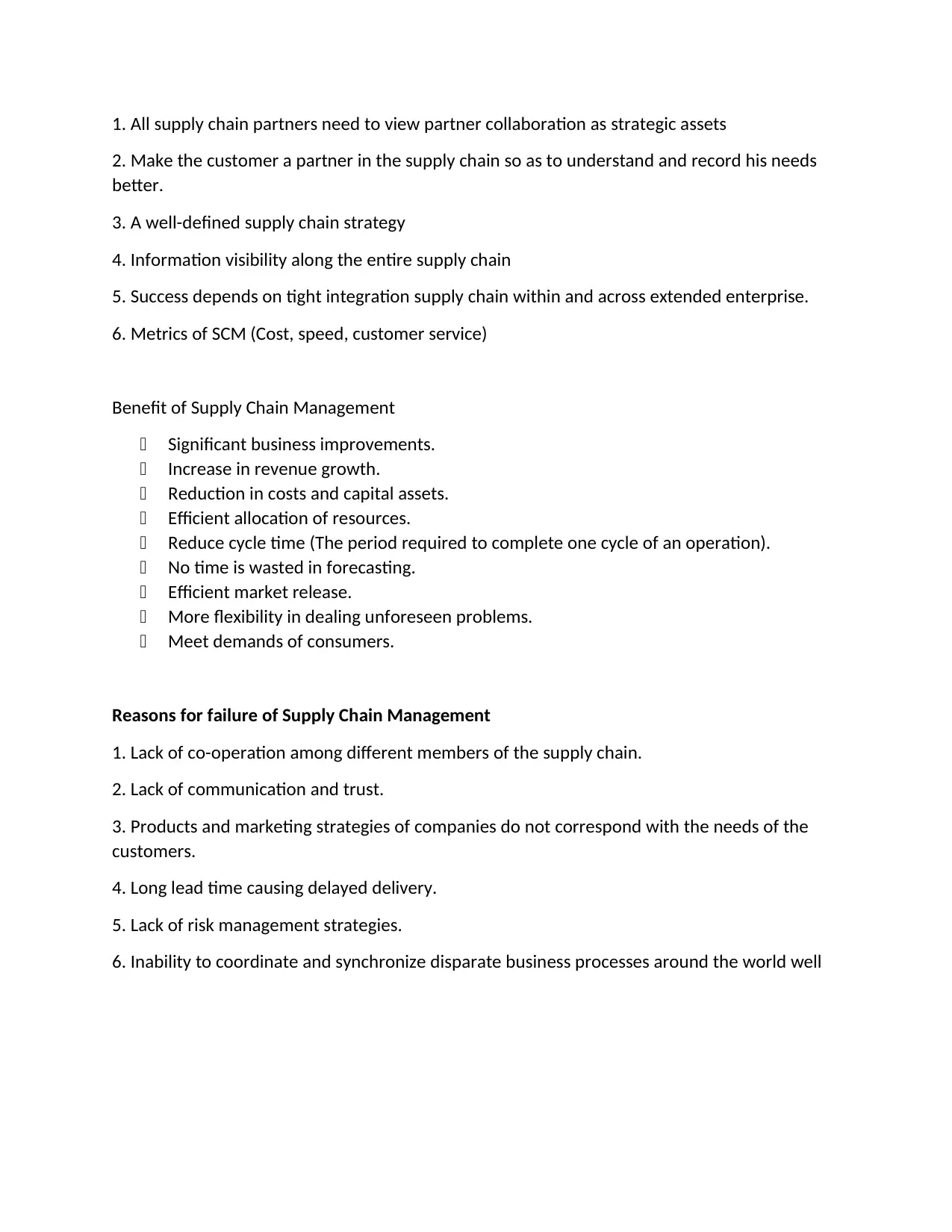
1. All supply chain partners need to view partner collaboration as strategic assets
2. Make the customer a partner in the supply chain so as to understand and record his needs
better.
3. A well-defined supply chain strategy
4. Information visibility along the entire supply chain
5. Success depends on tight integration supply chain within and across extended enterprise.
6. Metrics of SCM (Cost, speed, customer service)
Benefit of Supply Chain Management
Significant business improvements.
Increase in revenue growth.
Reduction in costs and capital assets.
Efficient allocation of resources.
Reduce cycle time (The period required to complete one cycle of an operation).
No time is wasted in forecasting.
Efficient market release.
More flexibility in dealing unforeseen problems.
Meet demands of consumers.
Reasons for failure of Supply Chain Management
1. Lack of co-operation among different members of the supply chain.
2. Lack of communication and trust.
3. Products and marketing strategies of companies do not correspond with the needs of the
customers.
4. Long lead time causing delayed delivery.
5. Lack of risk management strategies.
6. Inability to coordinate and synchronize disparate business processes around the world well
2. Make the customer a partner in the supply chain so as to understand and record his needs
better.
3. A well-defined supply chain strategy
4. Information visibility along the entire supply chain
5. Success depends on tight integration supply chain within and across extended enterprise.
6. Metrics of SCM (Cost, speed, customer service)
Benefit of Supply Chain Management
Significant business improvements.
Increase in revenue growth.
Reduction in costs and capital assets.
Efficient allocation of resources.
Reduce cycle time (The period required to complete one cycle of an operation).
No time is wasted in forecasting.
Efficient market release.
More flexibility in dealing unforeseen problems.
Meet demands of consumers.
Reasons for failure of Supply Chain Management
1. Lack of co-operation among different members of the supply chain.
2. Lack of communication and trust.
3. Products and marketing strategies of companies do not correspond with the needs of the
customers.
4. Long lead time causing delayed delivery.
5. Lack of risk management strategies.
6. Inability to coordinate and synchronize disparate business processes around the world well
⊘ This is a preview!⊘
Do you want full access?
Subscribe today to unlock all pages.

Trusted by 1+ million students worldwide
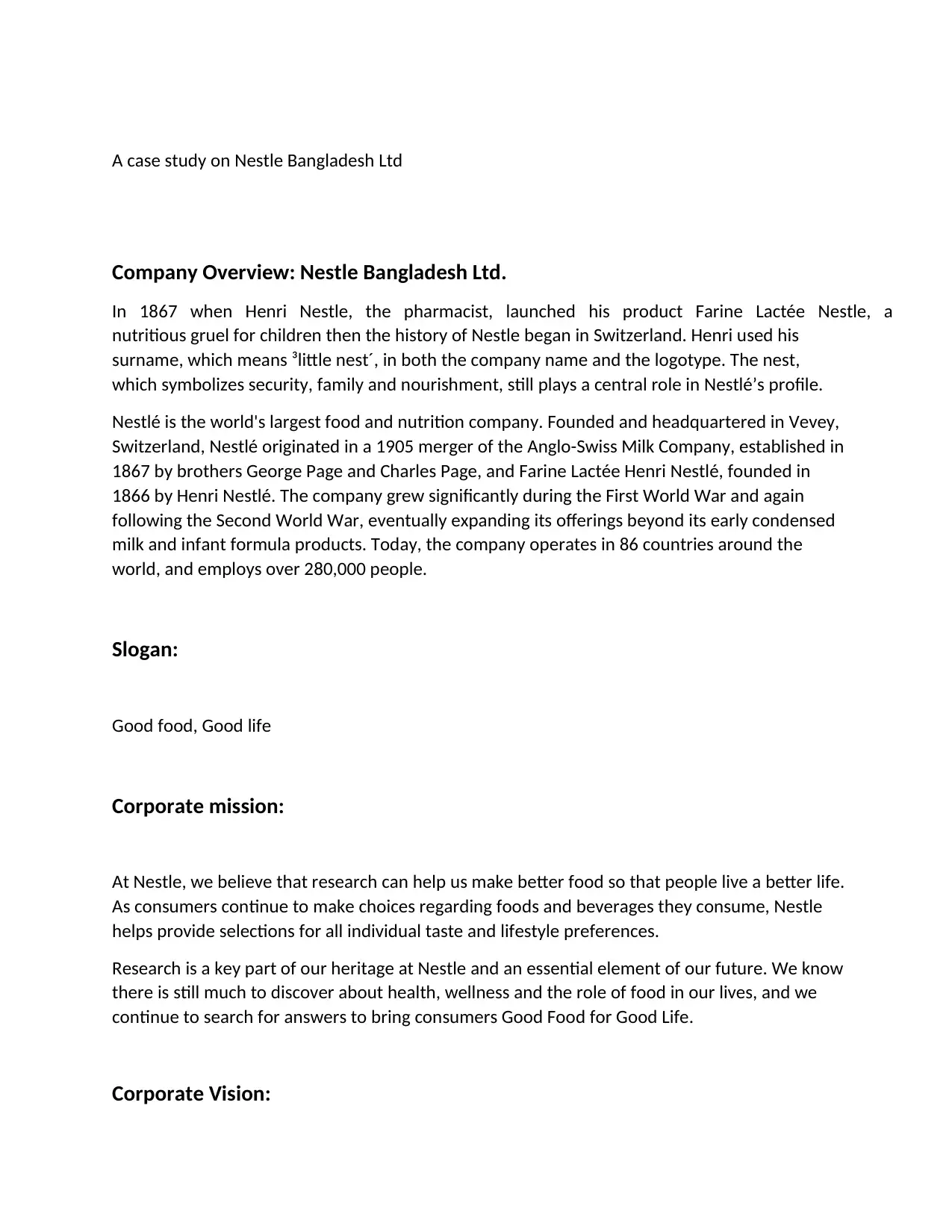
A case study on Nestle Bangladesh Ltd
Company Overview: Nestle Bangladesh Ltd.
In 1867 when Henri Nestle, the pharmacist, launched his product Farine Lactée Nestle, a
nutritious gruel for children then the history of Nestle began in Switzerland. Henri used his
surname, which means ³little nest´, in both the company name and the logotype. The nest,
which symbolizes security, family and nourishment, still plays a central role in Nestlé’s profile.
Nestlé is the world's largest food and nutrition company. Founded and headquartered in Vevey,
Switzerland, Nestlé originated in a 1905 merger of the Anglo-Swiss Milk Company, established in
1867 by brothers George Page and Charles Page, and Farine Lactée Henri Nestlé, founded in
1866 by Henri Nestlé. The company grew significantly during the First World War and again
following the Second World War, eventually expanding its offerings beyond its early condensed
milk and infant formula products. Today, the company operates in 86 countries around the
world, and employs over 280,000 people.
Slogan:
Good food, Good life
Corporate mission:
At Nestle, we believe that research can help us make better food so that people live a better life.
As consumers continue to make choices regarding foods and beverages they consume, Nestle
helps provide selections for all individual taste and lifestyle preferences.
Research is a key part of our heritage at Nestle and an essential element of our future. We know
there is still much to discover about health, wellness and the role of food in our lives, and we
continue to search for answers to bring consumers Good Food for Good Life.
Corporate Vision:
Company Overview: Nestle Bangladesh Ltd.
In 1867 when Henri Nestle, the pharmacist, launched his product Farine Lactée Nestle, a
nutritious gruel for children then the history of Nestle began in Switzerland. Henri used his
surname, which means ³little nest´, in both the company name and the logotype. The nest,
which symbolizes security, family and nourishment, still plays a central role in Nestlé’s profile.
Nestlé is the world's largest food and nutrition company. Founded and headquartered in Vevey,
Switzerland, Nestlé originated in a 1905 merger of the Anglo-Swiss Milk Company, established in
1867 by brothers George Page and Charles Page, and Farine Lactée Henri Nestlé, founded in
1866 by Henri Nestlé. The company grew significantly during the First World War and again
following the Second World War, eventually expanding its offerings beyond its early condensed
milk and infant formula products. Today, the company operates in 86 countries around the
world, and employs over 280,000 people.
Slogan:
Good food, Good life
Corporate mission:
At Nestle, we believe that research can help us make better food so that people live a better life.
As consumers continue to make choices regarding foods and beverages they consume, Nestle
helps provide selections for all individual taste and lifestyle preferences.
Research is a key part of our heritage at Nestle and an essential element of our future. We know
there is still much to discover about health, wellness and the role of food in our lives, and we
continue to search for answers to bring consumers Good Food for Good Life.
Corporate Vision:
Paraphrase This Document
Need a fresh take? Get an instant paraphrase of this document with our AI Paraphraser
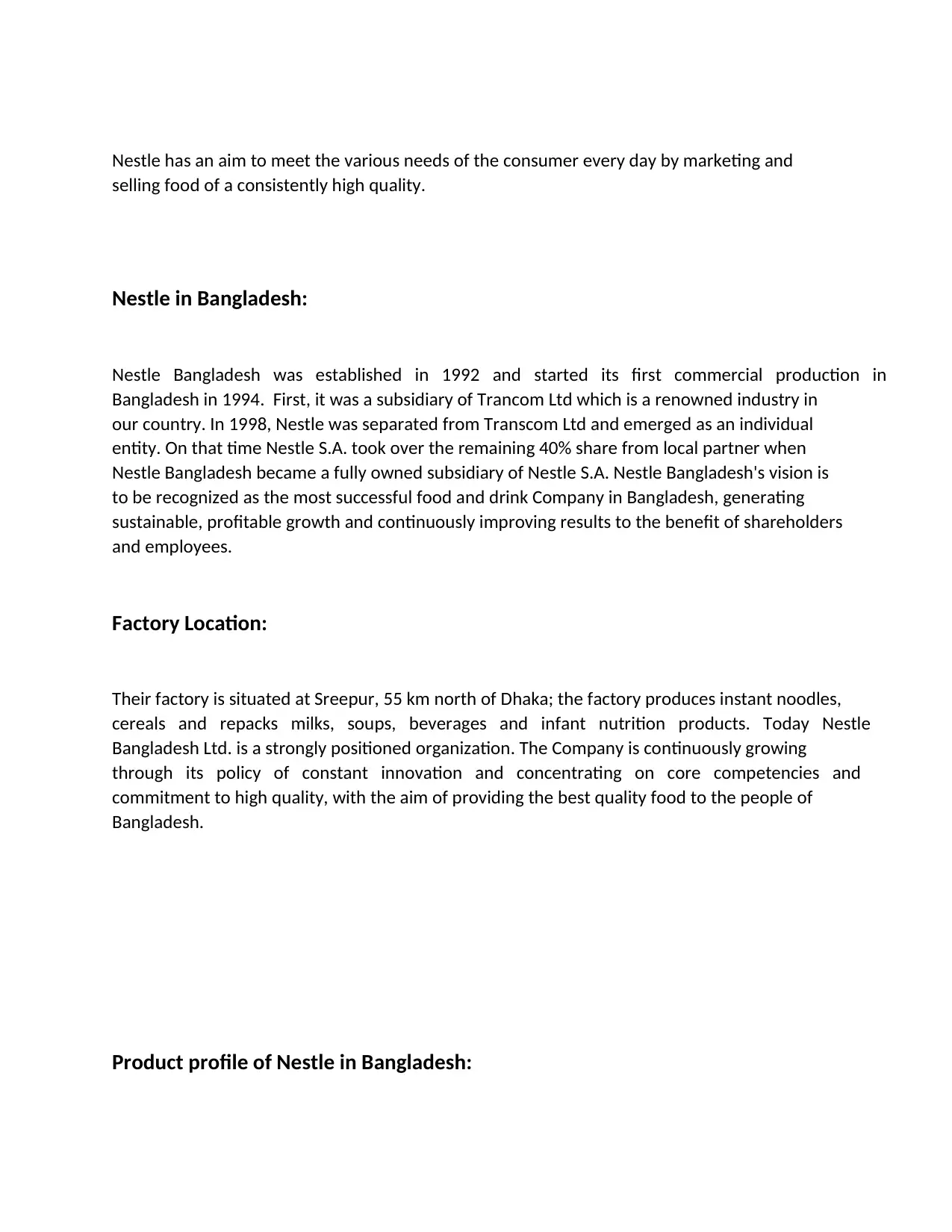
Nestle has an aim to meet the various needs of the consumer every day by marketing and
selling food of a consistently high quality.
Nestle in Bangladesh:
Nestle Bangladesh was established in 1992 and started its first commercial production in
Bangladesh in 1994. First, it was a subsidiary of Trancom Ltd which is a renowned industry in
our country. In 1998, Nestle was separated from Transcom Ltd and emerged as an individual
entity. On that time Nestle S.A. took over the remaining 40% share from local partner when
Nestle Bangladesh became a fully owned subsidiary of Nestle S.A. Nestle Bangladesh's vision is
to be recognized as the most successful food and drink Company in Bangladesh, generating
sustainable, profitable growth and continuously improving results to the benefit of shareholders
and employees.
Factory Location:
Their factory is situated at Sreepur, 55 km north of Dhaka; the factory produces instant noodles,
cereals and repacks milks, soups, beverages and infant nutrition products. Today Nestle
Bangladesh Ltd. is a strongly positioned organization. The Company is continuously growing
through its policy of constant innovation and concentrating on core competencies and
commitment to high quality, with the aim of providing the best quality food to the people of
Bangladesh.
Product profile of Nestle in Bangladesh:
selling food of a consistently high quality.
Nestle in Bangladesh:
Nestle Bangladesh was established in 1992 and started its first commercial production in
Bangladesh in 1994. First, it was a subsidiary of Trancom Ltd which is a renowned industry in
our country. In 1998, Nestle was separated from Transcom Ltd and emerged as an individual
entity. On that time Nestle S.A. took over the remaining 40% share from local partner when
Nestle Bangladesh became a fully owned subsidiary of Nestle S.A. Nestle Bangladesh's vision is
to be recognized as the most successful food and drink Company in Bangladesh, generating
sustainable, profitable growth and continuously improving results to the benefit of shareholders
and employees.
Factory Location:
Their factory is situated at Sreepur, 55 km north of Dhaka; the factory produces instant noodles,
cereals and repacks milks, soups, beverages and infant nutrition products. Today Nestle
Bangladesh Ltd. is a strongly positioned organization. The Company is continuously growing
through its policy of constant innovation and concentrating on core competencies and
commitment to high quality, with the aim of providing the best quality food to the people of
Bangladesh.
Product profile of Nestle in Bangladesh:
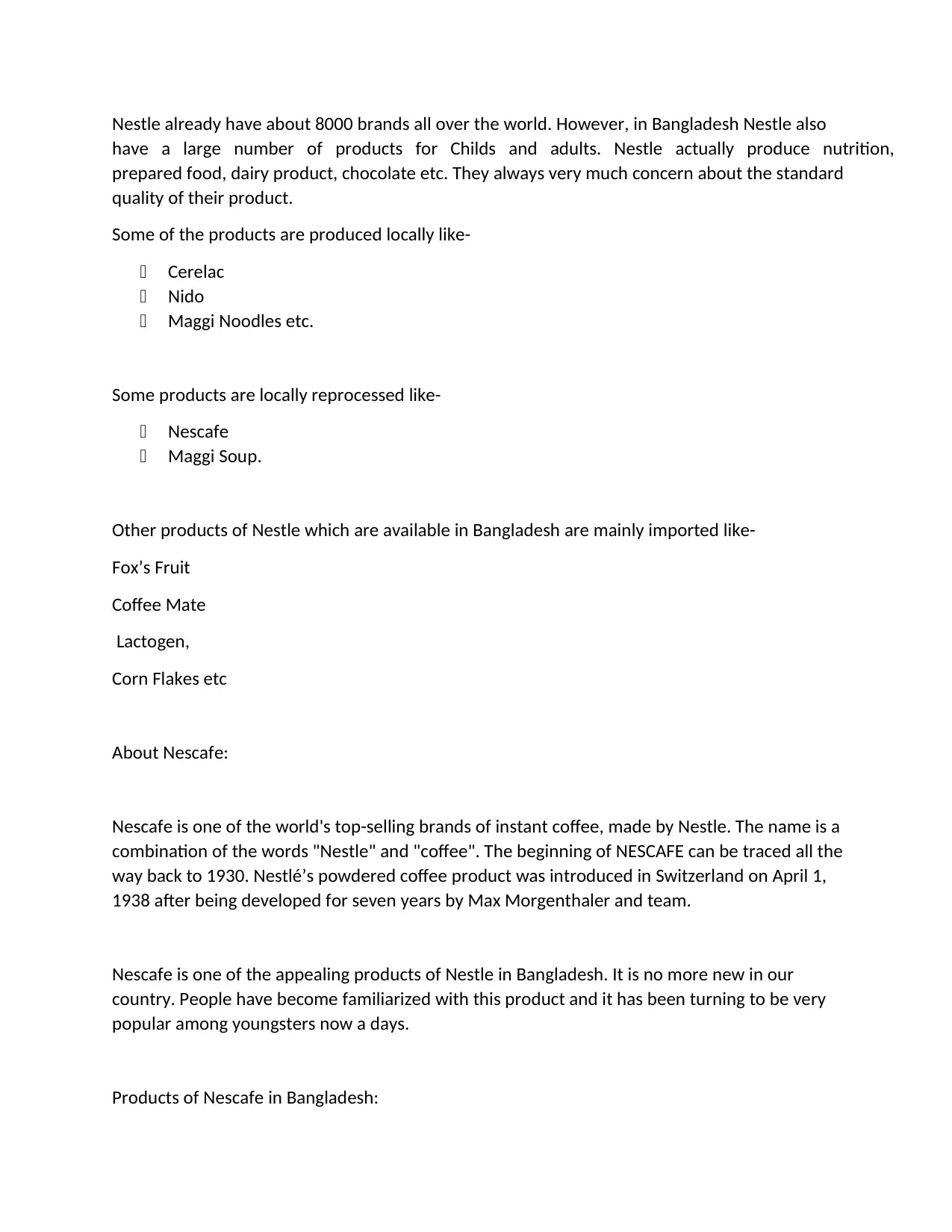
Nestle already have about 8000 brands all over the world. However, in Bangladesh Nestle also
have a large number of products for Childs and adults. Nestle actually produce nutrition,
prepared food, dairy product, chocolate etc. They always very much concern about the standard
quality of their product.
Some of the products are produced locally like-
Cerelac
Nido
Maggi Noodles etc.
Some products are locally reprocessed like-
Nescafe
Maggi Soup.
Other products of Nestle which are available in Bangladesh are mainly imported like-
Fox’s Fruit
Coffee Mate
Lactogen,
Corn Flakes etc
About Nescafe:
Nescafe is one of the world's top-selling brands of instant coffee, made by Nestle. The name is a
combination of the words "Nestle" and "coffee". The beginning of NESCAFE can be traced all the
way back to 1930. Nestlé’s powdered coffee product was introduced in Switzerland on April 1,
1938 after being developed for seven years by Max Morgenthaler and team.
Nescafe is one of the appealing products of Nestle in Bangladesh. It is no more new in our
country. People have become familiarized with this product and it has been turning to be very
popular among youngsters now a days.
Products of Nescafe in Bangladesh:
have a large number of products for Childs and adults. Nestle actually produce nutrition,
prepared food, dairy product, chocolate etc. They always very much concern about the standard
quality of their product.
Some of the products are produced locally like-
Cerelac
Nido
Maggi Noodles etc.
Some products are locally reprocessed like-
Nescafe
Maggi Soup.
Other products of Nestle which are available in Bangladesh are mainly imported like-
Fox’s Fruit
Coffee Mate
Lactogen,
Corn Flakes etc
About Nescafe:
Nescafe is one of the world's top-selling brands of instant coffee, made by Nestle. The name is a
combination of the words "Nestle" and "coffee". The beginning of NESCAFE can be traced all the
way back to 1930. Nestlé’s powdered coffee product was introduced in Switzerland on April 1,
1938 after being developed for seven years by Max Morgenthaler and team.
Nescafe is one of the appealing products of Nestle in Bangladesh. It is no more new in our
country. People have become familiarized with this product and it has been turning to be very
popular among youngsters now a days.
Products of Nescafe in Bangladesh:
⊘ This is a preview!⊘
Do you want full access?
Subscribe today to unlock all pages.

Trusted by 1+ million students worldwide
1 out of 20
Related Documents
Your All-in-One AI-Powered Toolkit for Academic Success.
+13062052269
info@desklib.com
Available 24*7 on WhatsApp / Email
![[object Object]](/_next/static/media/star-bottom.7253800d.svg)
Unlock your academic potential
Copyright © 2020–2025 A2Z Services. All Rights Reserved. Developed and managed by ZUCOL.





